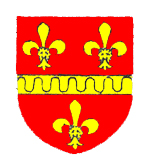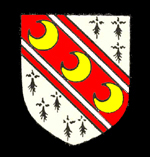Eaton Bray Castle
![The castle earthworks drawn by Frederick Gurney in 1911 [X325-146-1]](/CommunityHistories/EatonBray/EatonBrayImages/The castle earthworks drawn by Frederick Gurney in_350x273.jpg)
The castle earthworks drawn by Frederick Gurney in 1911 [X325/146/1]
Totternhoe Castle is well known, standing high above the surrounding countryside but Eaton Bray also had a castle. It stood west of the village in the angle between The Rye and Northall Road. As may be expected it was owned by the Lords of the Manor. Volume III of The Victoria County History for Bedfordshire was published in 1912 and states that the castle was built by William de Cantlowe in 1221 and was described by the Annals of Dunstable, written by chroniclers at Dunstable Priory, as “a serious danger to Dunstable and the neighbourhood”.

The Cantlowe family coat of arms
A particular of the manor made in 1273 describes the castle as a manor house inclosed with a wall and a moat with two drawbridges. There seems, in the manner of Norman castles to have been a large area inclosed by the wall (the outer bailey) and a smaller area within this, also inclosed by a wall (the inner bailey). There may also have been a mound, or motte, on which the principal residence was built (see the plan by Frederick Gurney at the head of this page – for a larger view please click on the image).
The hall had two chambers, a pantry and a buttery and the roofs were tiled. Also mentioned as being inside the inner bailey are: a great chamber; a foreign chamber (presumably for guests); a garderobe (a privy); a house for a larder used for a kitchen because there was no kitchen; a drawbridge opening out onto the deer park; a new chapel and a granary. The outer bailey contained stables with tiled roofs for sixty horses, a grange (usually meaning the manor house of a manor owned by a religious foundation but here, presumably, meaning a barn or something similar), cow houses, pigsties and other buildings which were all thatched. Outside the walls were two gardens, one of three roods and the other comprising one acre. The deep park included woodland of twenty eight acres.

The Bray family coat of arms
The castle is not mentioned after the 13th century and so may have had a short life of two or three generations. The Victoria County History states: “it is probable that the mansion house of the Bray family [who became Lords of the Manor in 1490] was rebuilt on the old site in the reign of Henry VIII. Part of this dwelling still remained in 1794, when it was taken down. Traces of the castle moat and foundations may still be seen in the parish, and persist in such place-names as Castle Field”.
The Bedfordshire Historic Environment Record [HER] contains information on the county’s historic buildings and landscapes and summaries of each entry can now be found online as part of the Heritage Gateway website. The site of the castle [HER 531] is also an ancient monument, scheduled by the former Ministry of Works in 1958. The schedule notes that the moat around the site is “an exceptionally well preserved example of a large, double island type”. These islands still retain the foundations of a number of structures, relating both to the original castle and the later manor house built on the site.
The outer enclosure surrounded by the moat measures 160 metres from north-east to south-west by 120 metres from north-west to south-east. The moat itself varies in width from 10 metres to 16 metres. The island within the moat stands about a metre above the top of the moat and is reached by a causeway measuring 40 metres across the north end of the south-eastern arm of the moat. The inner bailey, in the north-west corner of the larger island measures 60 metres in diameter. This island is 70 centimetres above the level of the moat and at this point the ditch is between 20 and 35 metres wide.

The Huxley family coat of arms
The castle was replaced by a manor house in the late 15th or early 16th century. By 1675, when the then owner Sir John Huxley died, the manor was empty. Huxley’s son, another John, undertook to repair the damage and a trust deed of February 1693 [AD3880] notes: “the manor house, where Sir John Huxley dwelt, has for many years been a considerable charge to repair and stands empty”. The property was described as: “the manorhouse called Eaton Park House, with barns, stables, outhouses, gardens, orchards and ground within the outward moats or ponds which do encompass the same; together with the same moats or ponds which are now laid dry with little or no water; a dovehouse called the stone dovehouse in the outer yard between the malthouse and the great barn”. As noted above the manor house was demolished in 1794 and by 1849 the site was clear of standing remains, the moated area being described as “park Gardens” in the tithe map of that year [MAT13].
The castle was surrounded by a deer park and this, as we have seen above, is mentioned in 13th century sources. The park was edged with a bank and ditch and comprised woodland and pasture. The schedule notes: “the construction of the deer park reflects a major change in land use, which may have involved the displacement of existing farming communities, evidence for which may survive in the buried land surfaces beneath the banks”.
The earliest reference to the deer park is in 1241. In 1274 the park is described as extending over twenty eight acres. Richard Clifford, an officer of King Edward I (1272-1307) was accused of taking venison from the park after the death of Lord of the Manor Gilbert de Cantlowe. When Frederick Gurney investigated the park in 1911 he found that the bank around the park, called the pale, was flanked by two ditches and was cut by an outlet for fishponds.
Fish were an important part of diet in the Middle Ages, particularly as the church laid down that meat could not be eaten on Fridays, resulting in that day becoming a day associated with eating fish instead. The fishponds at Eaton Bray lie 40 metres east of the moated site itself. One measures 28 metres north-south by 18 metres east-west and connects with a linear pond in its south-west corner. This second pond is 40 metres long and varies in width between 7 metres and 3 metres.